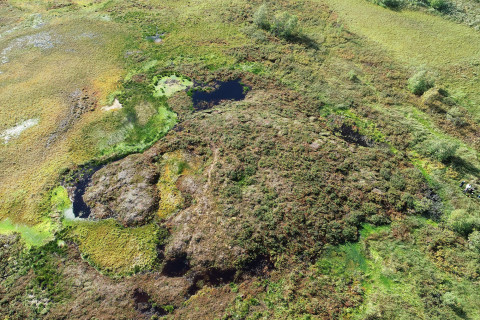The doctoral dissertation in the field of Physical Geography will be examined at the Faculty of Social Sciences and Business Studies at Joensuu campus. The public examination will be streamed online.
What is the topic of your doctoral research, and why is it important to study the topic?
The topic of my dissertation is the various processes related to permafrost degradation in Arctic and subarctic regions. Landscapes in these regions are rapidly changing due to pronounced climate warming. Permafrost degradation, in particular, can trigger cascading impacts on biodiversity, ecosystem services, socio-ecological systems, and climate through various feedback mechanisms, which are not yet fully understood. Better understanding of these processes is crucial for improving Earth System Models and projecting future Arctic development. In my dissertation, I focus on examining two distinct cases of permafrost landscape dynamics. Firstly, I investigate increasingly common landslides related to permafrost degradation and their impact on vegetation cover and reindeer herding in the central Yamal Peninsula in north-west Siberia. Secondly, I study changes in subarctic peatlands in north-west Finnish Lapland, where permafrost can be found in palsa mounds and plateaus.
What are the key findings or observations of your doctoral research?
The results of the first article showed that landslides have pronounced, long-lasting impacts on tundra vegetation and highlighted the importance of very high-resolution satellite data for mapping small landslides and temporary vegetation cover degradation. The satellite imagery time series also revealed a recent decline in Normalised Difference Vegetation Index commonly used to assess vegetation cover properties, which warrants further investigation. The second article contributed to the understanding of relationships between landscape structure, permafrost conditions, and reindeer habitat use. The results showed that landslide slopes and areas with tall willows were used by reindeer less than other habitats in the area, indicating their limited potential to suppress willow growth on landslide slopes through grazing and trampling. This is important because reindeer have been suggested to counteract impacts of climate warming and prevent open tundra areas from being overgrown by shrubs. Seasonal thaw depth was particularly deep on landslide slopes and under tall willows, but the reindeer habitat use does not seem to affect the permafrost conditions. The findings of the last two articles have implications particularly for the modelling of hydrological and biogeochemical processes of palsa mires, as thaw depth values used in the models are commonly derived based on the habitat classification, which does not reflect small-scale variability of thaw depth within palsas. The last two articles also underline the importance of accurate topographical data, both for monitoring permafrost degradation and estimating seasonal thaw depth in palsas.
What are the key research methods and materials used in your doctoral research?
The ‘coupled analysis’ in the title of my dissertation refers to the analyses of various combinations of remotely sensed data and data collected in the field. Overall, remote sensing is an overarching component in all four articles comprising this thesis. I used optical, thermal, and digital elevation data with varying temporal and spatial resolutions derived using a variety of platforms: satellites, aerial photography, and Unoccupied Aerial Systems. Diverse field measurements also played an important role, ranging from being basic ground truthing data (Article I) to serving as model training and testing data sets (Article III), and being a significant part of the entire research (Articles II and IV). Field data include land and vegetation cover observations, pellet-group counting for the analysis of reindeer habitat use, active-layer thickness measurements, which indicate the depth of seasonally thawing and freezing layer above permafrost, high-accuracy Real Time Kinematic GNSS measurements, and climate data acquired from local meteorological stations. Methods used encompass various remote sensing techniques, such as land cover change detection, manual feature mapping, digital terrain analyses and application of machine learning algorithms, as well as different statistical analyses.
I would like to highlight the importance of multidisciplinary and international collaborations in all four articles. Overall, a variety of perspectives and expertise, including local and indigenous knowledge, are crucial for gaining a deeper understanding of complex issues such as the impacts of climate warming in the Arctic.
The doctoral dissertation of Mariana Verdonen, MSc, entitled Periglacial landscape dynamics: coupled analysis of a changing Arctic using remote sensing and field observations will be examined at the Faculty of Social Sciences and Business Studies at Joensuu Campus on 22 March 2024, 12:00–15:00. The Opponent in the public examination will be Associate Professor Heather Reese of the University of Gothenburg, and the Custos will be Professor Timo Kumpula of the University of Eastern Finland. Language of the doctoral defence is English.
For further information, please contact:
MSc, Mariana Verdonen, mariana.verdonen@uef.fi


